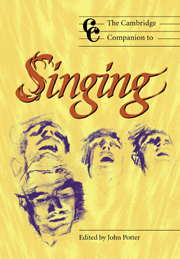Book contents
- Frontmatter
- 1 Introduction: singing at the turn of the century
- Part I Popular traditions
- Part II The voice in the theatre
- Part III Choral music and song
- 9 European art song
- 10 English cathedral choirs in the twentieth century
- 11 Sacred choral music in the United States: an overview
- Part IV Performance practices
- Notes
- Select bibliography
- Index
9 - European art song
from Part III - Choral music and song
Published online by Cambridge University Press: 28 September 2011
- Frontmatter
- 1 Introduction: singing at the turn of the century
- Part I Popular traditions
- Part II The voice in the theatre
- Part III Choral music and song
- 9 European art song
- 10 English cathedral choirs in the twentieth century
- 11 Sacred choral music in the United States: an overview
- Part IV Performance practices
- Notes
- Select bibliography
- Index
Summary
My involvement with this subject started in earnest at university, where I would take volumes of songs out of the library and read through them by the hundred. If I was in luck, a friendly pianist would help out for an hour or two, but more often than not I was on my own with my horrible piano playing. As a result I came to know much of the repertoire from within, as a performer, rather than from the point of view of a scholar or historian. The present chapter necessarily has a historical basis, but I would like to emphasise that this is not how I discovered the treasures of European song. Nothing can replace the experience of singing them for yourself (in a sound-proofed room if necessary), and I very much hope that readers of these pages will want to explore some of the highways and byways of this wonderful musical heritage.
What is an art song? First of all, it was intended to be accompanied by a keyboard, originally perhaps a harpsichord or fortepiano, later a pianoforte. Secondly, the poem (or sometimes a prose text) should have been chosen not only for its suitability as a song, but also for the composer's ability to identify with it and to express its meaning in an individual manner. Lastly, the intentions of the composer and the question of taste and discrimination have to be considered.
- Type
- Chapter
- Information
- The Cambridge Companion to Singing , pp. 109 - 122Publisher: Cambridge University PressPrint publication year: 2000

